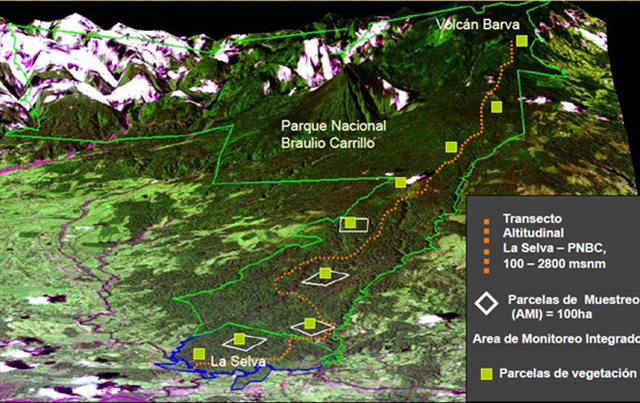Climate change pushing tropical trees upslope ‘exactly as predicted’ – ‘Dieback is happening much faster than expansion’
By Claire Salisbury
27 September 2013 (mongabay.com) – Tropical tree communities are moving up mountainsides to cooler habitats as temperatures rise, a new study in Global Change Biology has found. By examining the tree species present in ten one-hectare plots at various intervals over a decade, researchers found that the proportion of lowland species increased in the plots at higher elevations. The study, which was undertaken in Volcán Barva, Costa Rica, adds to a growing body of evidence that climate change is having an impact on species range distributions. As climate change leads to warmer temperatures, species must respond if they are to survive. One way to do this is to migrate to new habitats that become suitable (and away from old ones that become unsuitable); another way is to adapt to hotter temperatures, but the speed of climate change may be too fast for some species to evolve to keep up. In some cases, if their physiology permits it, species may be capable of tolerating increases in temperature, but the likelihood of this is unknown. The researchers first turned to herbarium records to calculate the preferred temperature of thousands of tree species, by looking at the geographic location of sampling locations and the temperature ranges they encompassed. With the temperature preferences for each species known, it was then possible to calculate a ‘community temperature score’ for each of the ten study plots, by averaging the preferred temperatures of all species present. A high community temperature score indicated an abundance of species found in the hot lowlands, whereas a low community temperature score reflected the presence of high altitude species from cooler habitats. Plots were monitored over the course of a decade, and in nine of the ten plots the community temperature score increased. This indicates a shift in species composition, with the relative abundance of lowland species increasing over time “exactly as predicted under climate-driven upward species migrations,” Kenneth Feeley, lead author of the study with Florida International University and Fairchild Tropical Botanic Garden, told mongabay.com. These changes corresponded to a mean thermal migration rate of 0.0065°C per year. However, over the past 60 years regional warming has been 0.0167°C per year, so the average migration rate observed across plots is not fast enough to keep up with the rate of warming. Still, encouragingly, when looked at individually, migration in 4 of the 10 plots did keep pace with regional warming. Changes in species composition can be the result of different processes: species abundance can change without shifts in the overall range distribution, ranges can shift, and ranges can expand or contract. Identifying which of these underlies changes in species composition is important, because “depending on which of these processes is occurring, predictions for the future of ‘migrating species’ will vary from positive (under range expansions), to neutral (under range shifts) to dire (under range contractions),” Feeley explains. To examine the specific causes of the compositional shifts in the study plots, the researchers measured stem growth, recruitment (the establishment of new trees), and mortality. They found that the main driver behind the increase in the relative abundance of lowland species upslope was in fact the disproportionate death of higher elevation species. “Our results indicate that dieback is happening much faster than expansion. This means that species’ ranges will shrink. As ranges shrink, species will be more and more prone to extinction,” Feeley said. An earlier study by Feeley and colleagues investigated related questions in the Peruvian Andes and came to similar conclusions, suggesting that their findings may be generally applicable across the tropics. “The rates of migration that we have documented for the forests of Costa Rica are remarkably similar to what we found in the Peruvian Andes. The rates are also fairly close to the maximum rates of migration recorded for tropical trees during the warming period that followed the last glacial maximum. As such, it appears that what we are observing is trees moving at their fastest,” Feeley said. “In the past, this was fast enough; it is not fast enough now and it certainly won’t be fast enough in the future.” […] “By far the single most important factor is how much warming the species can tolerate. If they can tolerate a significant amount of warming, then our predictions are relatively sanguine. If species are intolerant of warming, then their future will be dependent on migrations and predictions for the tropics become very bleak,” explains Feeley. [more]
Climate change pushing tropical trees upslope ‘exactly as predicted’
